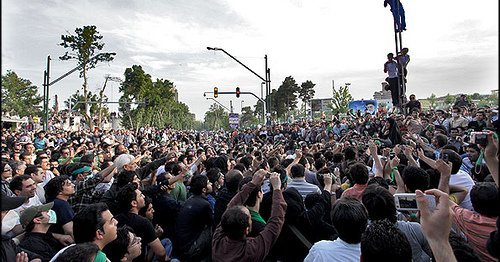Are the protests in Iran the beginning of a ‘coloured’ revolution as we have seen in Georgia and Ukraine? As the massive demonstrations after the Iranian presidential elections are comparable to the ones that overthrew the incumbent governments in Georgia [3] and Ukraine [4], in Iran they escalated into violence, arrests and killings.
Election fraud and disagreement with the government all led to the protests. Contrary to Iran, in Ukraine and Georgia the military and security forces didn’t move in to thwart the peaceful rallies, as they didn’t agree with the political elite and were afraid of civil war in case of a brutal crackdown. In both cases the opposition leaders had also the backing of important state institutions, such as the Supreme Court [5].
What’s happening in Iran isn’t a revolution, yet. People are displeased with the situation in their country, and Mahmoud Ahmadinejad is the symbol of their woes. His reelection angered a lot of people because of allegations of fraud, frustrations with the political and economic situation and disappointment.
However, the demonstrators don’t want to overthrow the regime. A minority does, but most protesters want more freedom within the system. A report of the renowned International Crisis Group mentions that ‘despite clear popular dissatisfaction with important aspects of its policy, especially among the youth, the regime remains stable, and few Iranians appear to want foreign-inspired domestic change’ [6].
The demonstrators don’t want to overthrow the regime.
Presidential candidate Mir-Hossein Mousavi belongs together with Kathami and Rafsanjani to a group of reformers within the Theocracy. One must remember, though, that Mousavi, Kathami and Rafsanjani were all devout followers of Khomeini during the high days of the Islamic Revolution. Although Mousavi pleaded for more freedom of expression, respect and promotion for human and women rights and a reform of the economic and foreign policy during his campaign, he’s not after the collapse of the regime. The reformers just want to change the course Iran is taking. It’s most likely that Mousavi lost control over the protests, and got ever more dragged into the quagmire.
Nevertheless, people voted for Mousavi because he was the only plausible alternative to Ahmadinejad, not because of his program. At the end of the day it is the Ayatollahs who reign in Iran. The president is a mere puppet whose hands are firmly tied. While Ahmadinejad is popular with the rural population, Mousavi and other reformers have a lot of adherents in the cities. This may indeed arouse some questions on the election result, as nearly 70% of the Iranians live in the cities. [7] However, Ahmadinejad strengthened his support among the lowest strata of society through popular measures. Raising incomes (which in turn had an abysmal effect on inflation), handing out food, infrastructure projects in rural areas.
On the eve of the elections the campaign team of Mr. Mousavi was already accused of preparing for a ‘velvet revolution’. According to an Iranian general their plan would be to announce their victory, and challenge the results in case they would lose [8]. This all seems scarily accurate to what happened. Could it be that the hardliners wanted this to happen, so they could consolidate their powerbase? During the protests several of the people arrested are big shots in the reformist camp [9] , journalists and students. The unusual period of liberty the week before the ballots can thus be seen as silence before the storm…
With their reluctance to comment on the Iranian elections and protests, the US and EU wanted to avoid the possibility for the Iranian regime to use potential critique as a way to harden its stance vis à vis the international community, because “the greater tensions with Washington are, the easier it is for the regime to rally supporters, suppress dissent and invoke national unity against a common enemy” [10] . However, the reluctance didn’t halt the Iranian regime to point its finger to the international community and accusing it of having a major hand into the protests.
Before the elections in Iran however, there seemed to be an improvement in the relations with the international community. Several incentives for this new relationship are the wars in Iraq and Afghanistan, the narco-trafficking from Afghanistan to Iran, the refugee problem, a common enemy (Taliban and radical Sunni Islam) and keeping the nuclear proliferation at bay. As the Ayatollahs are ever more accusing the West of interference and detaining British embassy personnel and a French academic [11], tensions rise and relations toughen.
It’s probably too early to claim that a new ‘coloured’ revolution won’t take place. At the moment a huge power struggle is taking place in the highest echelons of the regime between the reformers and the conservatives. However, as it was the case in 1979, no one saw the collapse of the Shah regime coming either. The Theocratic regime stands still firm, but in the long run the latest events will be marked as a precedent. The regime’s brutal oppression against hundreds of thousands of its subjects will not be easily forgotten.


Follow the comments: |
|
